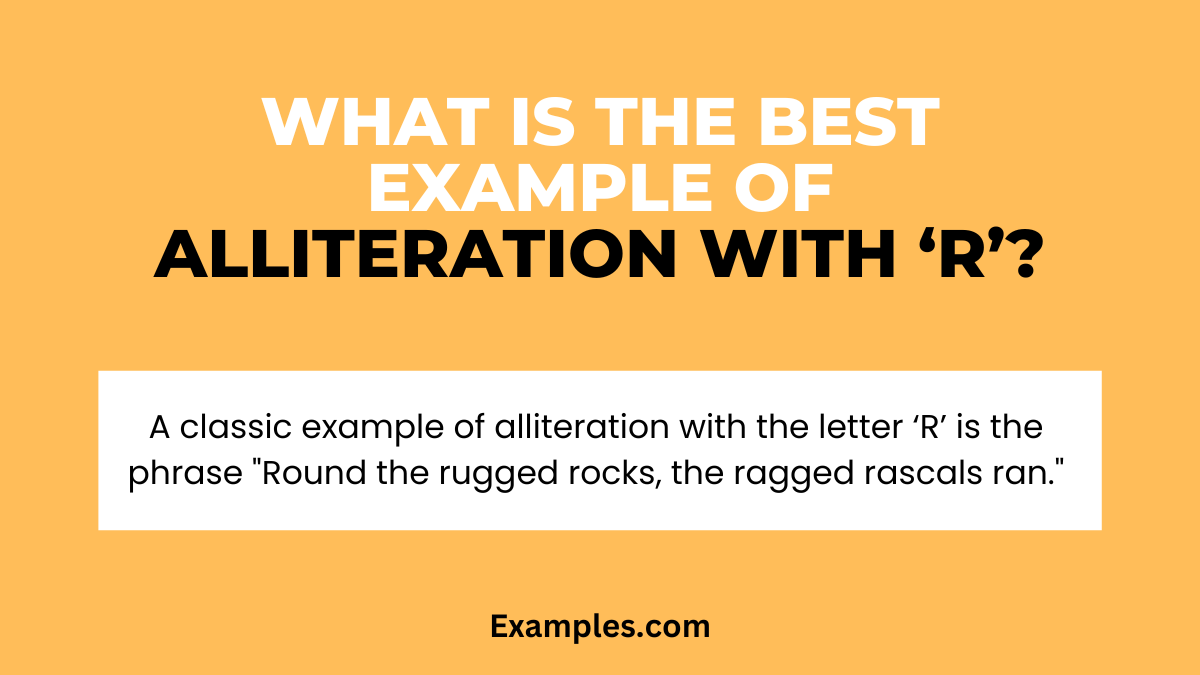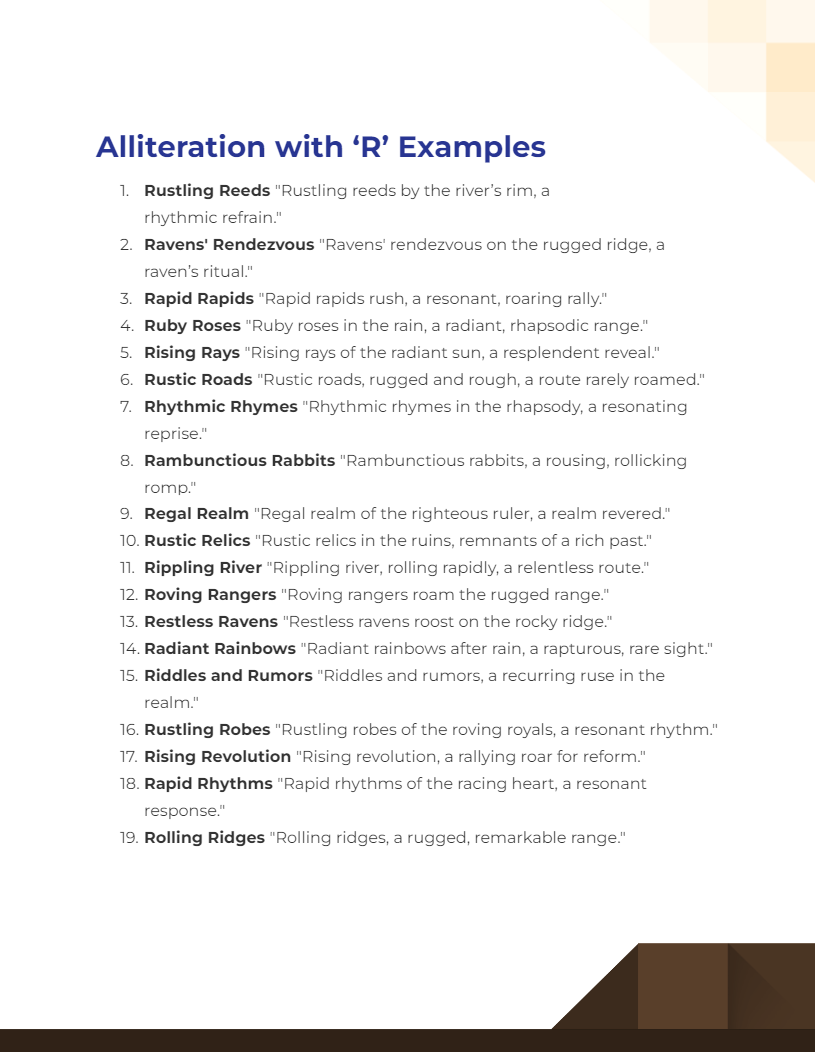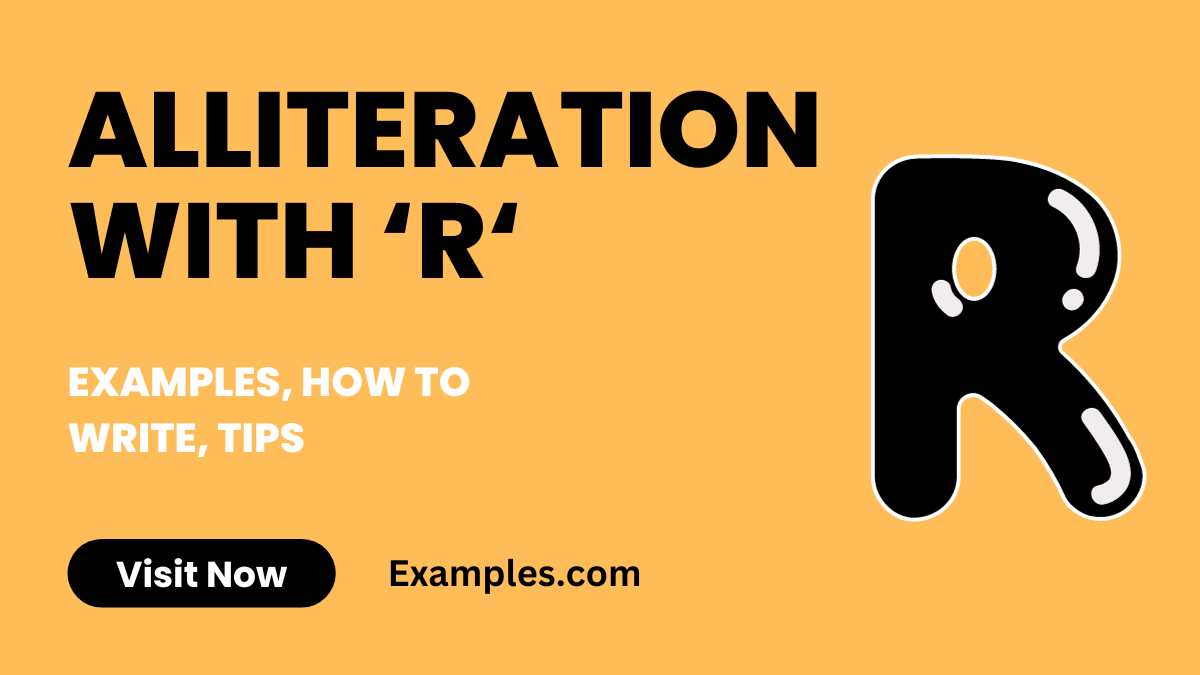19+ Alliteration with R Examples
Alliteration with ‘R’ resonates with a rhythmic and robust flair, adding a distinctive tone to literary works. This literary device, involving the repetition of the ‘R’ sound at the start of adjacent or closely connected words, can create a rolling or even rough sound pattern, depending on the context. It’s a powerful tool in poetry, storytelling, and persuasive writing, often used to evoke specific emotions or emphasize particular points. Utilizing famous alliterations with ‘R’ effectively can bring a sense of energy and motion to your writing, making it more captivating and memorable for the reader. It’s a creative way to enrich language and enhance the auditory appeal of your text, whether you’re composing a poem, a narrative, or crafting compelling marketing content.
Download Alliteration with 'R' Examples
Download Alliteration with 'A' to 'Z' Examples
What is the Best Example of Alliteration with ‘R’?

Example: A classic example of alliteration with the letter ‘R’ is the phrase “Round the rugged rocks, the ragged rascals ran.”
Meaning: Alliteration is a literary device that involves the repetition of the same initial consonant sound in a series of words or phrases. In the example, “Round the rugged rocks, the ragged rascals ran,” the consonant ‘R’ is repeated at the beginning of several words, creating a rhythmic and memorable sound pattern. This technique is often used in poetry, literature, and speeches to add emphasis, musicality, and a sense of unity to the text. In this specific example, the easy alliteration repeated ‘R’ sound adds a playful and whimsical quality to the sentence, making it both enjoyable to say and challenging to articulate quickly.
20 Alliteration with ‘R’ Examples

Download Alliteration with 'R' Examples in PDF
Alliteration with the letter ‘R’ radiates a resonance of rhythmic and riveting rhymes, rendering a robust and rousing auditory experience. The ‘R’ sound, known for its rolling and sometimes resonant quality, is excellent for crafting hard alliteration examples. Particularly effective in alliteration in rhymes, the ‘R’ sound adds a dynamic and engaging quality to verses. Here are 20 unique examples of alliteration with ‘R’, each accompanied by a rhyme title that captures the essence of the phrase.
- Rustling Reeds “Rustling reeds by the river’s rim, a rhythmic refrain.”
- Ravens’ Rendezvous “Ravens’ rendezvous on the rugged ridge, a raven’s ritual.”
- Rapid Rapids “Rapid rapids rush, a resonant, roaring rally.”
- Ruby Roses “Ruby roses in the rain, a radiant, rhapsodic range.”
- Rising Rays “Rising rays of the radiant sun, a resplendent reveal.”
- Rustic Roads “Rustic roads, rugged and rough, a route rarely roamed.”
- Rhythmic Rhymes “Rhythmic rhymes in the rhapsody, a resonating reprise.”
- Rambunctious Rabbits “Rambunctious rabbits, a rousing, rollicking romp.”
- Regal Realm “Regal realm of the righteous ruler, a realm revered.”
- Rustic Relics “Rustic relics in the ruins, remnants of a rich past.”
- Rippling River “Rippling river, rolling rapidly, a relentless route.”
- Roving Rangers “Roving rangers roam the rugged range.”
- Restless Ravens “Restless ravens roost on the rocky ridge.”
- Radiant Rainbows “Radiant rainbows after rain, a rapturous, rare sight.”
- Riddles and Rumors “Riddles and rumors, a recurring ruse in the realm.”
- Rustling Robes “Rustling robes of the roving royals, a resonant rhythm.”
- Rising Revolution “Rising revolution, a rallying roar for reform.”
- Rapid Rhythms “Rapid rhythms of the racing heart, a resonant response.”
- Rolling Ridges “Rolling ridges, a rugged, remarkable range.”
- Rhapsodic Revelations “Rhapsodic revelations, a rhythmic, resonant rapture.”
Alliteration Sentence Examples with ‘R’
Alliteration sentence examples with ‘R’ often create a rich, rhythmic effect, using the robust ‘R’ sound to enhance the narrative flow. This type of alliteration is prevalent in various literary forms, including alliteration in poems, songs, and movies, contributing to their memorable and melodic quality. Here are three examples:
- “Roger’s red robot raced around the rugged race track.”
- “Rebecca’s radiant roses rapidly rose in the radiant sunshine.”
- “Riley’s rambunctious retriever romped around the rainy garden.”
Alliteration Examples with ‘R’ Words
Alliteration examples using ‘R’ words demonstrate the power of this consonant in creating vivid, rhythmic phrases. Often utilized for its dynamic quality in alliteration in songs, the ‘R’ sound adds a lively, engaging element. Here are three examples:
- “Ravenous ravens reaped rewards from the ripe raspberry bushes.”
- “Rory’s remarkable recital received roaring applause from the audience.”
- “The rustic riverbank revealed rows of rare, radiant wildflowers.”
Alliteration Examples with ‘R’ Name
Incorporating names that start with ‘R’ in alliteration adds a personal touch to phrases, making them more relatable and vivid. Here are three examples:
- “Rachel’s radiant ruby ring reflected the room’s rich radiance.”
- “Ryan’s rapid response to the riddle revealed his remarkable reasoning.”
- “Rita’s rhapsodic renditions resonated through the rustic room.”
Alliteration Examples with ‘R’ Sound
The ‘R’ sound in alliteration can produce a range of effects, from energetic and bold to soft and rhythmic. These examples show diverse applications of the ‘R’ sound in alliterative structures. Here are three examples:
- “Rustic relics rested, revealing remnants of a bygone era.”
- “The rolling river ran rapidly, resonating with the rhythmic rain.”
- “Rough and rugged roads ran right through the rural regions.”
Alliteration Poems with ‘R’
An alliteration poem with ‘R’ uses the repetitive ‘R’ sound to create a rhythmic and engaging poetic experience. Alliteration in poems, especially with the ‘R’ sound, brings a unique lyrical quality. Here are three examples:
- “Rivers run, rivers rise, / Reflecting the raven’s wise eyes.”
- “Restless roads, rugged rides, / Rolling hills on either side.”
- “Raindrops rap, a rhythmic tune, / Resonating under the moon.”
Alliteration Beginning with ‘R’
Alliteration beginning with ‘R’ sets a specific tone and rhythm in a phrase, creating a memorable and impactful auditory experience. Found in various artistic expressions, including alliteration in movies, it adds a distinctive flair. Here are three examples:
- “Rosie’s round robin rested regally on the rustic railing.”
- “Randal’s rare records resonated in the roomy residence.”
- “Rapid rivers ran, rousing rumors of a rumored treasure.”
How to Write Alliteration with ‘R’?
Writing alliteration with the letter ‘R’ involves crafting sentences or phrases where words beginning with the ‘R’ sound are placed in close proximity. The ‘R’ sound, known for its rolling and resonant qualities, can add rhythm and emphasis to your writing. This technique is used in various contexts, from poetic compositions to educational materials like alliteration for first grade. Here’s how to create effective alliteration with ‘R’:
- Understand the ‘R’ Sound: Familiarize yourself with the ‘R’ sound. It’s a vibrant consonant that can bring energy and emphasis to your writing.
- Select a Theme or Concept: Choose a theme or subject. This will help you find relevant ‘R’ words that fit your topic, whether you’re crafting alliteration with answers or for creative expression.
- Brainstorm ‘R’ Words: List words starting with ‘R’. Include different types of words (nouns, verbs, adjectives) to enrich your alliteration.
- Formulate Your Phrase or Sentence: Construct a sentence or phrase using your chosen ‘R’ words. Aim for a natural flow that highlights the alliterative effect.
- Read Aloud for Rhythm: Alliteration’s effectiveness is often best judged audibly. Read your sentence aloud to ensure it flows well and the ‘R’ sound is pronounced clearly.
- Revise for Clarity and Impact: Ensure your alliterative phrase is clear and contributes effectively to your overall message or story.
- Apply in Various Contexts: Whether it’s in alliteration figurative language exercises, as part of teaching alliteration for first grade, or in creative writing, adapt your use of ‘R’ alliteration to suit the purpose and audience.
Tips for Using Alliteration with ‘R’
Here are the Tips for Using Alliteration with ‘R’:
- Use Sparingly: While alliteration can add style and rhythm, overusing it can overshadow your main message. Use it to emphasize key points or add stylistic flair in moderation.
- Maintain Clarity: Your primary goal is to convey a message clearly. Alliteration should complement, not complicate, your narrative.
- Vary Word Length and Complexity: Mix short and long ‘R’ words, as well as simple and complex words, for a more dynamic textual rhythm. This is particularly important in alliteration for first grade, where simpler language is necessary.
- Consider the Mood: The ‘R’ sound can be energetic and robust or soft and soothing. Use it in contexts where this mood is desired.
- Read and Revise: Reading your work aloud helps you assess the rhythm and flow. Adjust as needed to ensure the alliteration enhances the text.
- Appropriate for Audience: Tailor your alliteration to your audience. For instance, alliteration for first grade should be simpler and more playful than alliteration for adults.
- Explore Different Forms: Try ‘R’ alliteration in various forms of writing, from poetry and stories to advertising and academic work, to understand its effect.
Remember, the key to effective alliteration with ‘R’ is balancing its vibrant sound with readability, ensuring that the alliterative phrases add value to your writing.
What are the Alliteration with ‘R’ for Students?
Alliteration with ‘R’ for students serves as an effective tool in enhancing linguistic skills, including vocabulary development, phonetic awareness, and understanding of literary devices. ‘R’ alliterations for students can range from simple examples for younger learners to more complex ones for older students, making them suitable for various educational levels. Here are some examples:
- “Ricky’s robot repaired the red race car rapidly.”
- “Rebecca recited a robust report on Renaissance art.”
- “Ronald’s research on rare reptiles revealed remarkable results.”
These alliterations are used to teach alliteration for students, encouraging them to explore language in a creative and engaging manner.
What is the Effect of ‘R’ Letter in Alliteration?
The effect of the ‘R’ letter in alliteration is to create a rolling, resonant sound that adds rhythm and a sense of movement to language. The ‘R’ sound is one of the more vibrant consonant sounds, making it effective for drawing attention to specific phrases and enhancing the musicality of the text. In literature, ‘R’ alliteration is often used to create a dynamic tone, making it a popular choice in both alliteration for kids and more sophisticated works for adults. Its versatility makes it significant in both alliteration and assonance, contributing to the overall sonic appeal of a piece.
What is the Alliteration ‘R’ Type of?
Alliteration with the letter ‘R’ is a type of consonantal alliteration, where the consonant sound at the beginning of adjacent or closely connected words is repeated. It’s a common and effective literary device used in various forms of writing, from poetry to prose. The ‘R’ type of alliteration can create different effects, from lively and energetic to softer and more rhythmic, depending on the context and the words chosen. This form of alliteration is seen in a wide range of literary works and is a favorite in educational materials for its appeal and effectiveness, widely used in alliteration for students and in both alliteration and assonance. The ‘R’ alliteration’s ability to add a dynamic and rhythmic quality to writing makes it a versatile tool for writers and educators alike.


